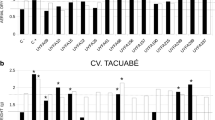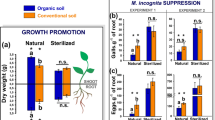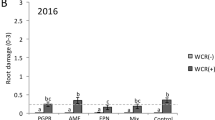Abstract
Purpose
Soil fauna are potential regulators of plant pathogens and soil nutrient cycles. However, direct evidence demonstrating faunal controls over pathogens and plant diseases is still limited. Interactions between diverse faunal groups, soilborne pathogen, and microbial community remain elusive.
Methods
The fungivorous nematode Aphelenchus avenae, two collembolan species (Hypogastrura perplexa and Sinella curviseta), and their combinations were introduced to test their suppression effects on the soilborne fungus Pythium ultimum in tomato, and impacts on microbial biomass and activities in soil.
Results
The introduction of A. avenae, H. perplexa and combinations of three faunal species decreased tomato seedlings damping-off incidence, and nematode suppressed P. ultimum population in the microcosms. The damping-off disease suppression efficiency is different between faunal treatments, with A. avenae and diverse faunal treatments were more efficient, followed by H. perplexa. The disease suppression effects of S. curviseta were poor. This may be attributed to the non-specific feeding preference of collembolan, different spatial niches and body size of three species. Furthermore, A. avenae and H. perplexa inoculation increased the soil respiration. S. curviseta increased the microbial biomass carbon and nitrogen in microcosms compared with other faunal treatments. These suggest that activities of soil fauna may promote microbial turnover and nutrient cycling to alleviate plant disease.
Conclusion
Fungivorous nematode A. avenae and collembola H. perplexa can promote the activities of soil microbes, and alleviate damping-off disease incidence caused by P. ultimum in tomato. Effective management of soil fauna is recommended to control root pathogens and maintain tomato health in organic farming systems.






Similar content being viewed by others
References
Baermann G (1917) Eine einfache Methode zur Auffindung von Ankylostomum (Nematoden)-Larven in Erdproben. Geneeskd Tijdschr Ned Indie 57:131–137
Bebber DP, Holmes T, Gurr SJ (2014) The global spread of crop pests and pathogens. Glob Ecol Biogeogr 23:1389–1407. https://doi.org/10.1111/geb.12214
Bollen GJ, Middelkoop J, Hofman TW (1990) Effects of soil fauna on infection of potato sprouts by Rhizoctonia solani. In: Beemster et al. (eds) Biotic interactions and soilborne diseases, Elsevier Science Publishers, Amsterdam, The Netherlands, pp 23–30
Briones MJI (2018) The serendipitous value of soil fauna in ecosystem functioning: The unexplained explained. Front Environ Sci 6:149. https://doi.org/10.3389/fenvs.2018.00149
Cabrera ML, Beare MH (1993) Alkaline persulfate oxidation for determining total nitrogen in microbial biomass extracts. Soil Sci Soc Am J 57:1007–1012. https://doi.org/10.2136/sssaj1993.03615995005700040021x
Carrión VJ, Perez-Jaramillo J, Cordovez V, Tracanna V, De Hollander M, Ruiz-Buck D, Mendes LW, van Ijcken WF, Gomez-Exposito R, Elsayed SS, Mohanraju P (2019) Pathogen-induced activation of disease-suppressive functions in the endophytic root microbiome. Science 366:606–612. https://doi.org/10.1126/science.aaw9285
Chauvat M, Gabriel P, Jean-François P (2014) Foraging patterns of soil springtails are impacted by food resources. Appl Soil Ecol 82:72–77. https://doi.org/10.1016/j.apsoil.2014.05.012
Chernova NM, Potapov MB, Savenkova YY, Bokova AI (2010) Ecological significance of parthenogenesis in collembola. Entmol Rev 90:23–38. https://doi.org/10.1134/S0013873810010033
Cohen MF, Yamasaki H, Mazzola M (2005) Brassica napus seed meal soil amendment modifies microbial community structure, nitric oxide production and incidence of Rhizoctonia root rot. Soil Biol Biochem 37:1215–1227. https://doi.org/10.1016/j.soilbio.2004.11.027
Coleman DC, Anderson RV, Cole CV, Elliott ET, Woods L, Campion MK (1977) Trophic interactions in soils as they affect energy and nutrient dynamics. IV. Flows of metabolic and biomass carbon. Microbiol Ecol 4:373–380. https://doi.org/10.1007/BF02013280
Coulibaly SFM, Winck BR, Akpa-Vinceslas M, Mignot L, Legras M, Forey E, Chauvat M (2019) Functional assemblages of collembola determine soil microbial communities and associated functions. Front Environ Sci 7:52. https://doi.org/10.3389/fenvs.2019.00052
Crowther TW, A’Bear AD (2012) Impacts of grazing soil fauna on decomposer fungi are species-specific and density-dependent. Fungal Ecol 5:277–281. https://doi.org/10.1016/j.funeco.2011.07.006
Crowther TW, van den Hoogen J, Wan J, Mayes MA, Keiser AD, Mo L, Averill C, Maynard DS (2019) The global soil community and its influence on biogeochemistry. Science 365:eaav0550. https://doi.org/10.1126/science.aav0550
Curl EA, Lartey RT (1996) Role of soil fauna in biological control of Rhizoctonia. In: Sneh B, Jabaji-Hare S, Neate S, Dijst G (eds) Rhizoctonia species: taxonomy, molecular biology, ecology, pathology and disease control. Springer, Netherlands, Dordrecht, pp 495–506
Curl EA, Old KM (1988) The role of soil microfauna in plant-disease suppression. Crit Rev Plant Sci 7:175–196. https://doi.org/10.1080/07352688809382263
Delgado-Baquerizo M, Guerra CA, Cano-Díaz C, Egidi E, Wang JT, Eisenhauer N, Singh BK, Maestre FT (2020) The proportion of soilborne pathogens increases with warming at the global scale. Nat Clim Chang 10:550–554. https://doi.org/10.1038/s41558-020-0759-3
Deng X, Zhang N, Li Y, Zhu C, Qu B, Liu H, Li R, Bai Y, Shen Q, Salles JF (2022) Bio-organic soil amendment promotes the suppression of Ralstonia solanacearum by inducing changes in the functionality and composition of rhizosphere bacterial communities. New Phyto. https://doi.org/10.1111/nph.18221
Diab HG, Hu S, Benson DM (2003) Suppression of Rhizoctonia solani on impatiens by enhanced microbial activity in composted swine waste-amended potting mixes. Phytopathology 93:1115–1123. https://doi.org/10.1094/PHYTO.2003.93.9.1115
Digel C, Riede JO, Brose U (2011) Body sizes, cumulative and allometric degree distributions across natural food webs. Oikos 120:503–509. https://doi.org/10.1111/j.1600-0706.2010.18862.x
El Titi A, Ulber B (1991) Significance of biotic interactions between soil fauna and microflora in integrated arable farming. Dev Agric Manag for Ecol 23:1–19. https://doi.org/10.1016/B978-0-444-88728-3.50005-6
El Mujtar V, Muñoz N, Prack Mc Cormick B, Pulleman M, Tittonell P (2019) Role and management of soil biodiversity for food security and nutrition; where do we stand? Glob Food Sec 20:132–144. https://doi.org/10.1016/j.gfs.2019.01.007
Elshahawy IE, El-Mohamedy RS (2019) Biological control of Pythium damping-off and root-rot diseases of tomato using Trichoderma isolates employed alone or in combination. J Plant Pathol 101:597–608. https://doi.org/10.1007/s42161-019-00248-z
Fisher JM, Davies KA (1990) On size and moulting of Aphelenchus avenae (Nematoda: Aphelenchida). Int J Parasitol 20:175–182. https://doi.org/10.1016/0020-7519(90)90098-8
Freckman DW, Ettema CH (1993) Assessing nematode communities in agroecosystems of varing human intervention. Agric Ecosyst Environ 45:239–261. https://doi.org/10.1016/0167-8809(93)90074-Y
Friberg H, Lagerlöf J, Rämert B (2005) Influence of soil fauna on fungal plant pathogens in agricultural and horticultural systems. Biocontrol Sci Technol 15:641–658. https://doi.org/10.1080/09583150500086979
Goncharov AA, Glebova AA, Tiunov AV (2020) Trophic interactions between Fusarium species and soil fauna: A meta-analysis of experimental studies. Appl Soil Ecol 145:103302. https://doi.org/10.1016/j.apsoil.2019.06.005
Gravel V, Martinez C, Antoun H, Tweddell RJ (2005) Antagonist microorganisms with the ability to control Pythium damping-off of tomato seeds in rockwool. Biocontrol 50:771–786. https://doi.org/10.1007/s10526-005-1312-z
Griffiths HM, Ashton LA, Parr CL, Eggleton P (2021) The impact of invertebrate decomposers on plants and soil. New Phytol 231:2142–2149. https://doi.org/10.1111/nph.17553
Guerra CA, Bardgett RD, Caon L, Crowther TW, Delgado-Baquerizo, et al (2021) Tracking, targeting, and conserving soil biodiversity. Science 371:239–241. https://doi.org/10.1126/science.abd7926
Haas D, Keel C (2003) Regulation of antibiotic production in root-colonizing Pseudomonas spp. and relevance for biological control of plant disease. Annu Rev Phytopathol 41:117–153. https://doi.org/10.1146/annurev.phyto.41.052002.095656
Hart SC, Stark JM, Davidson EA, Firestone MK (1994) Nitrogen mineralization, immobilization, and nitrification. In: Weaver et al. (eds) Methods of soil analysis: part 2 microbiological and biochemical properties, Soil Science Society of America Inc., Madison, pp 985–1018
Hendrix FF, Campbell WA (1973) Pythiums as plant pathogens. Annu Rev Phytopathol 11:77–98. https://doi.org/10.1146/annurev.py.11.090173.000453
Holmes KA, Benson DM (1994) Evaluation of Phytophthora parasitica var. nicotianae as a biocontrol for Phytophthora parasitica on Catharanthus roseus. Plant Dis 78:193–199. https://doi.org/10.1094/PD-78-0193
Ingham RE, Trofymow J, Ingham ER, Coleman DC (1985) Interactions of bacteria, fungi, and their nematode grazers: Effects on nutrient cycling and plant growth. Ecol Monogr 55:119–140. https://doi.org/10.2307/1942528
Jeffers SN, Martin SB (1986) Comparison of two media selective for Phytophthora and Pythium species. Plant Dis 70:1038–1043. https://doi.org/10.1094/PD-70-1038
Jorge-Escudero G, Pérez CA, Friberg H, Söderlund S, Vero S, Garmendia G, Lagerlöf J (2021) Contribution of anecic and epigeic earthworms to biological control of Fusarium graminearum in wheat straw. Appl Soil Ecol 166:103997. https://doi.org/10.1016/j.apsoil.2021.103997
Juroszek P, von Tiedemann A (2011) Potential strategies and future requirements for plant disease management under a changing climate. Plant Pathol 60:100–112. https://doi.org/10.1111/j.1365-3059.2010.02410.x
Klironomos JN, Kendrick WB (1995) Relationships among microarthropods, fungi, and their environment. Plant Soil 170:183–197. https://doi.org/10.1007/BF02183066
Koleva L, Ulber B, Wolf G (2014) The influence of collembola on the dissemination and antagonistic effect of Pseudomonas Fluorescens against Pythium ultimum in soil. Biotechnol Biotechnol Equip 23(sup1):293–296. https://doi.org/10.1080/13102818.2009.10818422
Lagerlöf J, Insunza V, Lundegårdh B, Rämert B (2011) Interaction between a fungal plant disease, fungivorous nematodes and compost suppressiveness. Acta Agric Scand B Soil Plant Sci 61:372–377. https://doi.org/10.1080/09064710.2010.488655
Lamichhane JR, Dürr C, Schwanck AA, Robin M-H, Sarthou J-P, Cellier V, Messéan A, Aubertot J-N (2017) Integrated management of damping-off diseases. A Review Agron Sustain Dev 37:10. https://doi.org/10.1007/s13593-017-0417-y
Lartey RT (2006) Dynamics of soil flora and fauna in biological control of soil inhabiting plant pathogens. Plant Pathol J 5:125–142. https://doi.org/10.3923/ppj.2006.125.142
Lartey RT, Curl EA, Peterson CM, Harper JD (1989) Mycophagous grazing and food preference of Proisotoma minuta (Collembola: Isotomidae) and Onychiurus encarpatus (Collembola: Onychiuridae). Environ Entomol 18:334–337. https://doi.org/10.1093/ee/18.2.334
Lee Q, Widden P (1995) Folsomia candida, a “fungivorous” collembolan, feeds preferentially on nematodes rather than soil fungi. Soil Biol Biochem 28:689–690. https://doi.org/10.1016/0038-0717(95)00158-1
Löbmann MT, Vetukuri RR, de Zinger L, Alsanius BW, Grenville-Briggs LJ, Walter AJ (2016) The occurrence of pathogen suppressive soils in Sweden in relation to soil biota, soil properties, and farming practices. Appl Soil Ecol 107:57–65. https://doi.org/10.1016/j.apsoil.2016.05.011
Lootsma M, Scholte K (1997a) Effects of the springtail Folsomia fimetaria and the nematode Aphelenchus avenae on Rhizoctonia solani stem infection of potato at temperatures of 10 and 15°C. Plant Pathol 46:203–208. https://doi.org/10.1046/j.1365-3059.1997.d01-228.x
Lootsma M, Scholte K (1997b) Effect of soil moisture content on the suppression of Rhizoctonia stem canker on potato by the nematode Aphelenchus avenae and the springtail Folsomia fimetaria. Plant Pathol 46:209–215. https://doi.org/10.1046/j.1365-3059.1997.d01-229.x
Lussenhop J (1992) Mechanisms of microarthropod-microbial interactions in soil. Adv Ecol Res 23:1–33. https://doi.org/10.1016/S0065-2504(08)60145-2
Macfadyen A (1961) Improved funnel-type extractors for soil arthropods. J Anim Ecol 30:171–184. https://doi.org/10.2307/2120
Maeder P, Fliebach A, Dubois D, Gunst L, Fried P, Niggli U (2002) Soil fertility and biodiversity in organic farming. Science 296:1694–1697. https://doi.org/10.1126/science.1071148
Meyer-Wolfarth F, Schrader S, Oldenburg E, Weinert J, Brunotte J (2017) Collembolans and soil nematodes as biological regulators of the plant pathogen Fusarium culmorum. J Plant Dis Prot 124:493–498. https://doi.org/10.1007/s41348-017-0111-y
Mommer L, Cotton TEA, Raaijmakers JM, Termorshuizen AJ, van Ruijven J, Hendriks M, van Rijssel SQ, van de Mortel JE, van der Paauw JW, Schijlen E, Smit-Tiekstra AE, Berendse F, de Kroon H, Dumbrell AJ (2018) Lost in diversity: the interactions between soilborne fungi, biodiversity and plant productivity. New Phytol 218:542–553. https://doi.org/10.1111/nph.15036
Moore JC, Walter DE, Hunt HW (1988) Arthropod regulation of micro- and mesobiota in below-ground detrital food webs. Annu Rev Entomol 33:419–435. https://doi.org/10.1146/annurev.en.33.010188.002223
Moore JC, McCann K, de Ruiter PC (2005) Modeling trophic pathways, nutrient cycling, and dynamic stability in soils. Pedobiologia 49:499–510. https://doi.org/10.1016/j.pedobi.2005.05.008
Neher DA (2010) Ecology of plant and free-living nematodes in natural and agricultural soil. Annu Rev Phytopathol 48:371–394. https://doi.org/10.1146/annurev-phyto-073009-114439
Newbery F, Qi A, Fitt BDL (2016) Modelling impacts of climate change on arable crop diseases: progress, challenges and applications. Curr Opin Plant Biol 32:101–109. https://doi.org/10.1016/j.pbi.2016.07.002
Nicholas WL (1984) The Biology of Free-living Nematodes. Clarendon, Oxford
Okada H, Kadota I (2003) Host status of 10 fungal isolates for two nematode species, Filenchus misellus and Aphelenchus avenae. Soil Biolo Biochem 35:1601–1607. https://doi.org/10.1016/j.soilbio.2003.08.004
Pal KK, Gardener BM (2006) Biological control of plant pathogens. Plant Health Instr 2:1117–1142. https://doi.org/10.1094/phi-a-2006-1117-02
Paul PA, Bradley CA, Madden LV, Lana FD, Bergstrom GC, Dill-Macky R, Esker PD, Wise KA, McMullen M, Grybauskas A, Kirk WW, Milus E, Ruden K (2018) Meta-analysis of the effects of qoi and dmi fungicide combinations on Fusarium head blight and deoxynivalenol in wheat. Plant Dis 102:2602–2615. https://doi.org/10.1094/PDIS-02-18-0211-RE
Pliego C, Ramos C, de Vicente A, Cazorla FM (2011) Screening for candidate bacterial biocontrol agents against soilborne fungal plant pathogens. Plant Soil 340:505–520. https://doi.org/10.1007/s11104-010-0615-8
Potapov AM, Rozanova OL, Semenina EE, Leonov VD, Belyakova OI, Bogatyreva VY, Degtyarev MI, Esaulov AS, Korotkevich AY, Kudrin AA, Malysheva EA, Mazei YA, Tsurikov SM, Zuev AG, Tiunov AV (2021) Size compartmentalization of energy channeling in terrestrial belowground food webs. Ecology e03421. https://doi.org/10.1002/ecy.3421
Qiu Z, Egidi E, Liu H, Kaur S, Singh BK (2019) New frontiers in agriculture productivity: optimised microbial inoculants and in situ microbiome engineering. Biotechnol Adv 37:107371. https://doi.org/10.1016/j.biotechadv.2019.03.010
Raaijmakers JM, Paulitz TC, Steinberg C, Alabouvette C, Moënne-Loccoz Y (2009) The rhizosphere: A playground and battlefield for soilborne pathogens and beneficial microorganisms. Plant Soil 321:341–361. https://doi.org/10.1007/s11104-008-9568-6
Sabatini MA, Innocenti G (2000) Soilborne plant pathogenic fungi in relation to some collembolan species under laboratory conditions. Mycol Res 104:1197–1201. https://doi.org/10.1017/s0953756200003026
Schrader S, Wolfarth F, Oldenburg E (2013) Biological control of soilborne phytopathogenic fungi and their mycotoxins by soil fauna: a review. Bull Univ Agric Sci Vet Med Cluj Napoca Agric 70:291–298
Schroth MN, Hancock JG (1982) Disease-suppressive soil and root-colonizing bacteria. Science 216:1376–1381. https://doi.org/10.1126/science.216.4553.1376
Shiraishi H, Enami Y, Okano S (2003) Folsomia hidakana (Collembola) prevents damping-off disease in cabbage and Chinese cabbage by Rhizoctonia solani. Pedobiologia 47:33–38. https://doi.org/10.1078/0031-4056-00167
Six J, Frey SD, Thiet RK, Batten KM (2006) Bacterial and fungal contributions to carbon sequestration in agroecosystems. Soil Sci Soc Am J 70:555–569. https://doi.org/10.2136/sssaj2004.0347
Taylor MCG (2010) Mycophagous soil fauna for biological control of soilborne pathogenic fungi in greenhouse and transplant crops. North Carolina State University, Raleigh
Thimm T, Hoffman A, Borkott H, Munch JC, Tebbe CC (1998) The gut of the soil microarthropod Folsomia candida (Collembola) is a frequently changeable but selective habitat and a vector for microorganisms. Appl Environ Microbiol 64:2660–2669. https://doi.org/10.1128/AEM.64.7.2660-2669.1998
Vance ED, Brookes PC, Jenkinson DS (1987) An extraction method for measuring soil microbial biomass C. Soil Biol Biochem 19:703–707. https://doi.org/10.1016/0038-0717(87)90052-6
Wall DH, Nielsen UN, Six J (2015) Soil biodiversity and human health. Nature 528:69–76. https://doi.org/10.1038/nature15744
Wiggins EA, Curl EA (1979) Interactions of collembola and microflora of cotton rhizosphere. Phytopathology 69:244–249. https://doi.org/10.1094/Phyto-69-244
Wolfarth F, Schrader S, Oldenburg E, Weinert J (2013) Nematode-collembolan-interaction promotes the degradation of Fusarium biomass and deoxynivalenol according to soil texture. Soil Biol Biochem 57:903–910. https://doi.org/10.1016/j.soilbio.2012.11.001
Wright DH, Huhta V, Coleman DC (1989) Characteristics of defaunated soil II. Effects of reinoculation and the role of the mineral component. Pedobiologia 33:427–435
Xu X, Jeger M (2021) More ecological research needed for effective biocontrol of plant pathogens. In: De Cal A, Melgarejo P, Magan N (eds) How research can stimulate the development of commercial biological control against plant diseases. Springer Nature, Switzerland, pp 15–30
Zhao J, Wang K (2021) Methods for cleaning turbid nematode suspensions collected from different land-use types and soil types. Soil Ecol Lett. https://doi.org/10.1007/s42832-021-0115-1
Acknowledgements
We thank Karen Parker for her help during the whole experiment. We are grateful to H. G. Diab EI-Arab, Howard David Shew and Mary Barbercheck for their useful suggestions. Acknowledgement is also extended to Guillermo Ramirez for his help with N determination. The research was supported by the grants from the USDA-NRI (2000-00531), National Natural Science Foundation of China (Grant No. 31901192) and the Fundamental Research Funds for the Central Universities.
Author information
Authors and Affiliations
Contributions
P. Z., W. Z. and S. H. conceived and designed the study. P. Z. analyzed the data and wrote the first draft of manuscript, all authors edited the manuscript and approved the final version to submit.
Corresponding author
Ethics declarations
The authors declare no competing interests.
Additional information
Responsible Editor: Sven Marhan.
Publisher's note
Springer Nature remains neutral with regard to jurisdictional claims in published maps and institutional affiliations.
Supplementary Information
Below is the link to the electronic supplementary material.
Rights and permissions
Springer Nature or its licensor holds exclusive rights to this article under a publishing agreement with the author(s) or other rightsholder(s); author self-archiving of the accepted manuscript version of this article is solely governed by the terms of such publishing agreement and applicable law.
About this article
Cite this article
Zhang, P., Zhang, W. & Hu, S. Fungivorous nematode Aphelenchus avenae and collembola Hypogastrura perplexa alleviate damping-off disease caused by Pythium ultimum in tomato. Plant Soil 482, 175–189 (2023). https://doi.org/10.1007/s11104-022-05680-2
Received:
Accepted:
Published:
Issue Date:
DOI: https://doi.org/10.1007/s11104-022-05680-2




